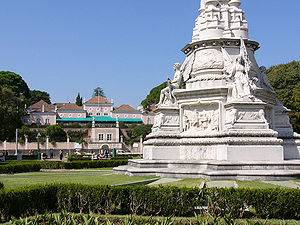
Afonso de Albuquerque Square
Encyclopedia

Lisbon
Lisbon is the capital city and largest city of Portugal with a population of 545,245 within its administrative limits on a land area of . The urban area of Lisbon extends beyond the administrative city limits with a population of 3 million on an area of , making it the 9th most populous urban...
, Portugal
Portugal
Portugal , officially the Portuguese Republic is a country situated in southwestern Europe on the Iberian Peninsula. Portugal is the westernmost country of Europe, and is bordered by the Atlantic Ocean to the West and South and by Spain to the North and East. The Atlantic archipelagos of the...
.
The square is located in front of Belém Palace
Belém Palace
The Belém National Palace, or alternately National Palace of Belém, has, overtime, been the official residence of Portuguese monarchs and, after the installation of the First Republic, the Presidents of the Portuguese Republic...
, a 17th-18th century palace that nowadays serves as residence for the President of Portugal
President of Portugal
Portugal has been a republic since 1910, and since that time the head of state has been the president, whose official title is President of the Portuguese Republic ....
. The square is named after the first conqueror of India
Portuguese India
The Portuguese Viceroyalty of India , later the Portuguese State of India , was the aggregate of Portugal's colonial holdings in India.The government started in 1505, six years after the discovery of a sea route to India by Vasco da Gama, with the nomination of the first Viceroy Francisco de...
, Afonso de Albuquerque
Afonso de Albuquerque
Afonso de Albuquerque[p][n] was a Portuguese fidalgo, or nobleman, an admiral whose military and administrative activities as second governor of Portuguese India conquered and established the Portuguese colonial empire in the Indian Ocean...
, and offers the best views of Belém Palace. It has a beautiful monument, in neo-Manueline
Manueline
The Manueline, or Portuguese late Gothic, is the sumptuous, composite Portuguese style of architectural ornamentation of the first decades of the 16th century, incorporating maritime elements and representations of the discoveries brought from the voyages of Vasco da Gama and Pedro Álvares Cabral...
style, by artists Silva Pinto and Costa Mota tio, inaugurated in 1902. The monument carries a bronze statue of Afonso de Albuquerque and has interesting reliefs about his life.
The site of the square used to be a harbour, built in 1753. In 1807, Queen Mary I
Maria I of Portugal
Maria I was Queen regnant of Portugal and the Algarves from 1777 until her death. Known as Maria the Pious , or Maria the Mad , she was the first undisputed Queen regnant of Portugal...
, Prince John VI
John VI of Portugal
John VI John VI John VI (full name: João Maria José Francisco Xavier de Paula Luís António Domingos Rafael; (13 May 1767 – 10 March 1826) was King of the United Kingdom of Portugal, Brazil and the Algarves (later changed to just King of Portugal and the Algarves, after Brazil was recognized...
and the royal family fled Lisbon from this harbour to Rio de Janeiro
Rio de Janeiro
Rio de Janeiro , commonly referred to simply as Rio, is the capital city of the State of Rio de Janeiro, the second largest city of Brazil, and the third largest metropolitan area and agglomeration in South America, boasting approximately 6.3 million people within the city proper, making it the 6th...
, in Brazil
Brazil
Brazil , officially the Federative Republic of Brazil , is the largest country in South America. It is the world's fifth largest country, both by geographical area and by population with over 192 million people...
, to escape the Napoleonic troops which had invaded Portugal
Peninsular War
The Peninsular War was a war between France and the allied powers of Spain, the United Kingdom, and Portugal for control of the Iberian Peninsula during the Napoleonic Wars. The war began when French and Spanish armies crossed Spain and invaded Portugal in 1807. Then, in 1808, France turned on its...
.
See also
- Belém PalaceBelém PalaceThe Belém National Palace, or alternately National Palace of Belém, has, overtime, been the official residence of Portuguese monarchs and, after the installation of the First Republic, the Presidents of the Portuguese Republic...
- Nacional Coach Museum

